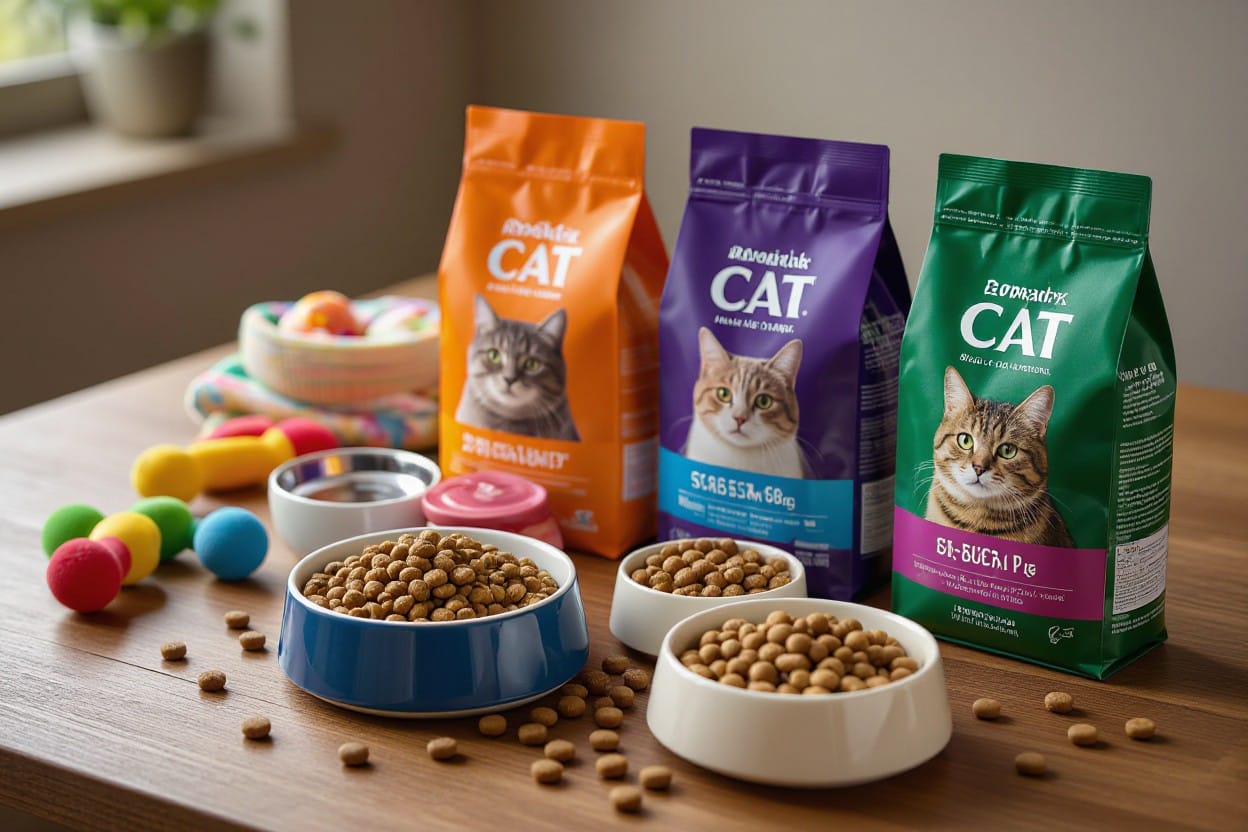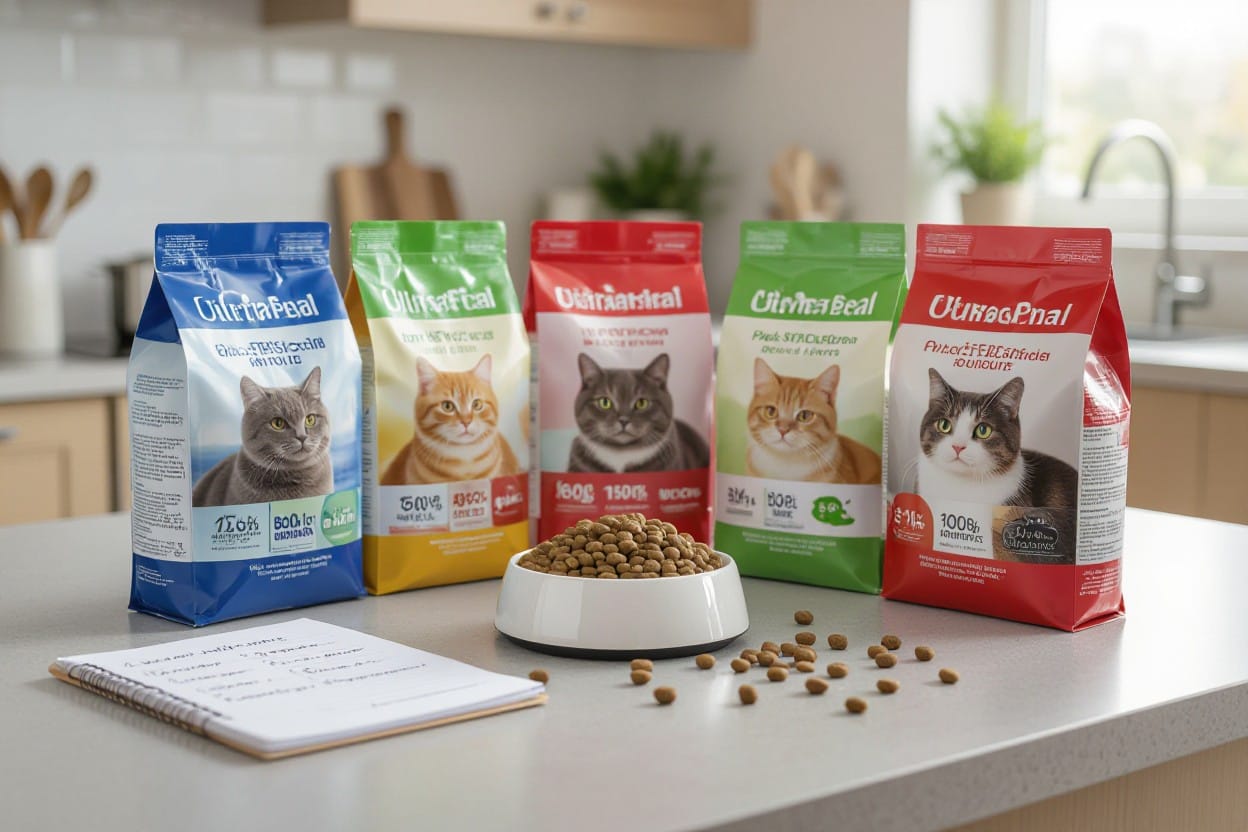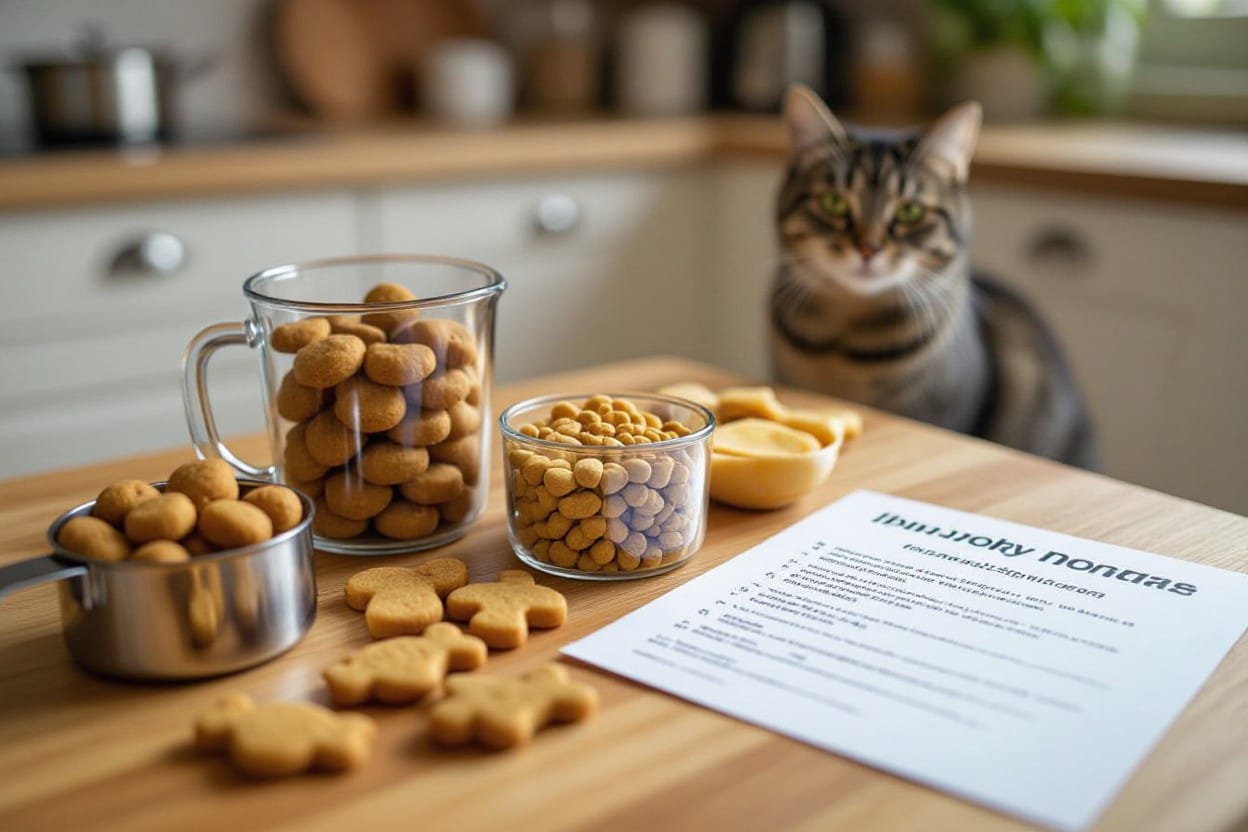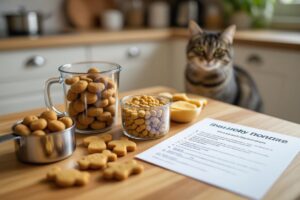Just use this veterinarian-led guide to choosing a cat food brand to evaluate labels, prioritize high-quality animal protein, and steer clear of dangerous additives and excess fillers; it shows you how to choose the right cat food by checking AAFCO statements, life-stage formulas, ingredient sourcing, and your cat’s needs to strengthen your understanding cat nutrition.

Key Takeaways:
- Use a veterinarian-reviewed guide to choosing a cat food brand: prioritize named animal proteins, an AAFCO statement, and life-stage suitability.
- When deciding how to choose the right cat food, match formulation to age, health conditions, and calorie needs; use limited-ingredient trials for suspected sensitivities.
- Prioritize high-quality protein, taurine, appropriate fats, and controlled carbs—understanding cat nutrition lets you evaluate labels and ingredient quality.
Understanding Cat Nutritional Needs
The Importance of a Balanced Diet
Look for foods labeled “complete and balanced” that meet AAFCO profiles; those guarantees mean the product was formulated to supply minimums such as AAFCO’s adult maintenance baseline of roughly 26% crude protein and 9% crude fat for dry formulas. Feeding a diet that balances high-quality animal protein, adequate fat for energy and palatability, plus imperative vitamins and minerals reduces risks of obesity, urinary problems, and micronutrient deficiencies that you might otherwise miss when rotating unverified homemade recipes.
Evaluate ingredient lists and guaranteed analysis together: named animal proteins (chicken, salmon, turkey) high on the list increase the chance of bioavailable amino acids, while vague meat meals and high unnamed carbohydrates can dilute nutrient density. Using this section of your guide to choosing a cat food brand, prioritize products that state complete formulation and provide feeding guidelines adjusted for weight, activity and life stage so you can feed precise calories rather than guessing.
Obligate Carnivore Requirements
Cats require nutrients found almost exclusively in animal tissue: taurine, arachidonic acid, preformed vitamin A, and sufficient arginine. Taurine deficiency produces dilated cardiomyopathy and central retinal degeneration; arginine deficiency can trigger acute hyperammonemia after a single arginine-free meal, causing neurologic signs. You should therefore choose diets where animal protein sources are primary and supplementation is verified rather than relying on plant-based protein concentrates.
Metabolic adaptations in cats favor protein and fat as primary energy sources, and carbohydrate tolerance is limited; diets very high in starch can worsen obesity and glycemic control in susceptible cats. If you’re assessing how to choose the right cat food, inspect labels for animal-source ingredients early in the list and avoid products that substitute large amounts of corn, wheat or peas for protein.
Many homemade or vegetarian approaches require precise supplementation to meet obligate carnivore needs; without laboratory-formulated recipes you risk life-threatening deficiencies. When you consider alternative diets, insist on nutrient analysis from a veterinary nutritionist or choose commercial diets with established feeding trials.
Life Stage Considerations
Kittens, adults and reproducing queens have distinct nutrient and energy demands: AAFCO growth/reproduction profiles typically require higher minimums (for example, around 30% crude protein) and greater calorie density than adult maintenance formulas. You should feed kitten or growth formulas until full skeletal maturity—commonly around 9–12 months for most cats, but extended to 12–24 months for large breeds like Maine Coons—so bone, brain and immune development receive the necessary protein and fat.
Seniors may need fewer calories but not necessarily less protein; preserving lean mass reduces frailty and supports immune function. If you’re using this guide to choosing a cat food brand for an aging cat, prioritize high-quality protein sources and nutrients that support joint and renal health while adjusting portion sizes to avoid weight gain.
Transition timing matters: switch gradually over 7–10 days and reassess body condition score monthly, because inappropriate transitions or prolonged feeding of growth diets to inactive adult cats can accelerate obesity and metabolic disease.
Health Condition Modifications
Specific diseases demand tailored diets: chronic kidney disease benefits from reduced phosphorus and controlled high-quality protein with added omega‑3s to slow progression; diabetes often responds better to higher-protein, lower-carbohydrate formulations to improve glycemic control; and lower-magnesium, urine-pH–targeted diets reduce struvite crystal risk. Prescription therapeutic diets are formulated to these aims, and you should follow veterinary guidance rather than improvising changes based on trends.
Obesity management focuses on caloric restriction with preserved protein to maintain muscle, while food intolerances may necessitate hydrolyzed or novel-protein diets. For urinary disease, note that manipulating pH and mineral content can prevent recurrence of specific crystal types—one diet won’t suit every urinary problem, so accurate diagnosis guides the right formulation.
Always coordinate therapeutic diet changes with diagnostic monitoring: unmonitored protein or phosphorus restriction, arbitrary supplementation, or abrupt diet swaps can worsen conditions. Work with your veterinarian for lab-based targets and periodic rechecks to confirm the diet is delivering the intended clinical benefit.

Reading Cat Food Labels Like a Pro
Ingredient List Interpretation
Scan the ingredient list from left to right: ingredients are listed by weight before cooking, so “chicken” listed first can be misleading because fresh meat contains roughly 70% water and shrinks during processing, while “chicken meal” is concentrated and often supplies more usable protein per gram. Look for named animal proteins (e.g., “chicken,” “salmon,” “duck”) rather than vague terms like “meat” or “animal,” and note that organ meats and by-products can be valuable sources of vitamins and taurine — the latter being an imperative amino acid for cats.
Watch for specific additives and preservatives: mixed tocopherols and rosemary extract are common natural preservatives, while BHA/BHT are synthetics some owners avoid. Ingredients listed at the bottom, like probiotics, omega-3 sources (EPA/DHA), or added taurine, can be positive signals, but you should prioritize the form and proportion of primary protein sources when comparing options in your guide to choosing a cat food brand.
Guaranteed Analysis Breakdown
Guaranteed Analysis shows minimums for crude protein and crude fat, and maximums for crude fiber and moisture; it doesn’t reflect digestibility or amino acid profile. To compare foods, convert to dry matter: use the formula (nutrient% ÷ (100 − moisture%)) × 100. Example: a label with 30% crude protein and 10% moisture becomes 30 ÷ 90 × 100 = 33.3% protein on a dry matter basis, which lets you compare wet and dry formulas accurately.
Calories per serving (kcal) and calorie density materially affect portion sizes and weight management; many dry cat foods fall between about 300–500 kcal per cup, so a single “1/3 cup” feeding guideline can represent a very different caloric load between brands. Also note that crude protein includes both animal and plant sources and doesn’t indicate imperative amino acid adequacy — for cats you must verify sources and look for added taurine or high-quality animal meals.
High crude ash levels often indicate a higher mineral residue and can correlate with lower-quality or less digestible ingredients; if you see ash markedly higher than competing formulas, treat that as a warning sign and seek alternatives with better digestibility data or feeding trial evidence.
Marketing Claims vs. Reality
Terms like “natural,” “human-grade,” and “real chicken” are frequently used for marketing and don’t guarantee superior nutrition. A label that touts “high protein” should be cross-checked against the guaranteed analysis and dry matter protein — you may find a kibble claiming 40% protein on a wet basis actually provides much less when moisture is accounted for. Beware of “grain-free” hype: after investigations in other species, grain-free diets were linked to heart issues in dogs; for cats evidence is limited, but you should not assume grain-free equals better without veterinary guidance and nutritional justification.
Proprietary blends and vague ingredient names are red flags because they hide proportions of ingredients; limited-ingredient diets can help after a proper elimination trial, but you should use them only under veterinary direction. Verify substantive claims by checking for AAFCO statements, feeding trial disclosures, or third-party testing rather than taking marketing language at face value when you’re deciding how to choose the right cat food.
Independent verification such as published feeding trials, nutrient guarantees on a dry matter basis, or COAs from accredited labs provides stronger evidence than flashy packaging or celebrity endorsements; if a manufacturer can’t provide test data on request, that lack of transparency is a practical negative point in your evaluation.
AAFCO Standards Explanation
Two AAFCO pathways allow a product to claim “complete and balanced”: formulation to meet AAFCO nutrient profiles, or successful AAFCO feeding trials. Labels stating “formulated to meet AAFCO Cat Food Nutrient Profiles” rely on ingredient math, whereas “animal feeding tests using AAFCO procedures” indicates live-animal trials and typically greater assurance of palatability, digestibility, and real-world nutrient availability for the life stage claimed (e.g., growth/reproduction vs. adult maintenance).
State agencies enforce AAFCO model regulations, so AAFCO itself isn’t a federal regulator but sets the widely accepted benchmarks for nutrient sufficiency. For your guide to choosing a cat food brand, prioritize foods that either have documented feeding trials or transparent formulation data that clearly match the life stage and health needs of your cat.
Therapeutic or prescription diets go beyond AAFCO’s “complete and balanced” scope and should be used when a veterinarian prescribes them; AAFCO compliance doesn’t equate to suitability for disease-specific needs, so consult your vet for conditions like chronic kidney disease, urinary stones, or diabetes.
Top Cat Food Brand Analysis
Premium Brand Comparisons
Orijen and Acana deliver high animal-protein formulas, with Orijen often listing crude protein in the high 30s to low 40s (%) on adult dry recipes and a heavy inclusion of fresh or raw ingredients. Royal Canin focuses on breed- and condition-specific formulations (e.g., Persian Adult, Renal Support), backed by clinical trials and veterinary recommendations, while Hill’s Science Diet and Farmina strike a balance between clinical evidence and ingredient quality.
Expect price differentials: premium kibbles commonly run from about $4–8 per pound depending on protein source and fresh meat content. You should weigh benefits like specialized nutrient profiles and feeding-trial validation against cost and your cat’s tolerances—some cats show better stool quality on premium fish- or poultry-forward formulas, others show no difference.
Premium Brand Snapshot
| Brand | Why it stands out |
|---|---|
| Orijen | Very high animal-protein content, multiple fresh whole-prey ingredients; aimed at biologically appropriate diets. |
| Acana | High-quality regional ingredients, slightly lower protein than Orijen but more affordable premium option. |
| Royal Canin | Extensive breed- and condition-specific recipes with vet-focused formulations and clinical data. |
| Hill’s Science Diet / Prescription | Strong research backing and clear veterinary indications; prescription line covers renal, GI, urinary and weight management. |
| Farmina | European formulations emphasizing limited ingredients, good digestibility, and moderate to high protein ratios. |
| Blue Buffalo (Wilderness) | Protein-focused “wilderness” line with common premium proteins; watch for by-product inclusion in some lines. |
Budget-Friendly Quality Options
Purina Pro Plan and Purina ONE offer many formulas with controlled macronutrient profiles and AAFCO statements, often delivering good nutrient adequacy at lower cost. You can find adult maintenance dry diets in the $1.50–3.50 per pound range that still include named meat meals (chicken, salmon) and added taurine, DHA, and vitamins.
Iams and Nutro provide affordable lines focused on digestibility and balanced micronutrient mixes; several peer-reviewed digestibility studies show comparable stool quality and nutrient absorption between mid-range and premium diets for healthy adult cats. You should check guaranteed analysis numbers—aim for protein in the high 20s to low 30s (%) for typical dry adult maintenance kibbles.
Look for an AAFCO statement on the label and clear primary protein sources; cost savings are reasonable only if the formula meets your cat’s life stage needs and you monitor body condition and stool consistency weekly.
Prescription Diet Considerations
Prescription diets target specific pathologies: Hill’s k/d reduces phosphorus and protein levels to slow chronic kidney disease progression; Royal Canin Veterinary Diets include urinary SO formulas that manage struvite and calcium oxalate risk by controlling urinary pH and mineral content. For diabetes, high-protein, moderate-carbohydrate diets paired with insulin management can improve glycemic control.
Use prescription diets under veterinary supervision—laboratory monitoring (CBC, biochemistry, urinalysis) should occur every 3–6 months for chronic disease patients. Switching off a therapeutic diet without a clear plan can worsen outcomes; some renal patients experience measurable declines in creatinine and improved appetite within 4–12 weeks on renal-specific formulas.
Be aware of potential pitfalls: feeding a renal diet to a healthy cat long-term without indication can lead to unnecessary nutrient restriction; always confirm diagnosis and re-evaluate response to the diet with follow-up labs and weight checks.
Grain-Free vs. Grain-Inclusive Debate
Grain-free marketing rose from perceived carb intolerance, but documented food allergies in cats occur in around 1–2% of cases, usually reacting to protein sources rather than grains. Most healthy cats tolerate digestible grains (rice, oats) well; focus on important amino acids like taurine, arginine, and methionine rather than simply the presence or absence of grains.
Regulatory reviews (including post-2018 canine DCM investigations) highlight the need to assess overall nutrient balance rather than demonize grains. If you choose a grain-free diet, verify the formula supplies adequate taurine and consult your vet for cardiac baseline screening if your cat has a history of heart disease.
Check guaranteed analysis and calculate estimated carbohydrate content by subtraction (100% − %protein − %fat − %moisture − %ash ≈ %carbs) so you can make an informed decision aligned with your goals in this guide to choosing a cat food brand and in your process of understanding cat nutrition to determine how to choose the right cat food for your cat.
Wet vs. Dry Food Decision Matrix
Nutritional Differences
Wet food typically contains about 70–80% moisture, which directly reduces the risk of dehydration-related urinary concentration; dry kibble usually has 6–10% moisture, making you responsible for encouraging water intake. Protein content can vary widely, but many high-quality wet formulas provide higher proportions of named animal proteins per calorie and lower carbohydrate content than typical dry diets; dry foods often rely on starches to bind kibble and can contain 20–40% digestible carbohydrate by weight, which increases obesity risk if you overfeed.
Taurine, EPA/DHA, and AAFCO-compliant nutrient balances are non-negotiable regardless of format; confirm the label lists a named protein (chicken, turkey, salmon) and an AAFCO statement for your cat’s life stage. Cats with chronic kidney disease or recurrent urinary obstruction often do better on higher-moisture wet diets because increased daily water intake lowers urine specific gravity and reduces struvite/crystal formation.
Cost Analysis
Dry diets generally cost less per calorie: a typical adult indoor cat needing ~200–250 kcal/day will consumes about 0.6–0.8 cups of many dry formulas, which for mainstream premium brands may run roughly $0.30–$1.00 per day; feeding the same caloric needs with wet food often costs $0.80–$3.00 per day, depending on can size and formula. Bulk buying, subscription discounts, or larger bag sizes can reduce the per-day cost of dry food, whereas wet food economies rely on multi-can packs or pouches from the same brand.
Choosing the lowest-priced option can be a false economy if the formula lacks named proteins or has excessive fillers; higher carbohydrate dry foods increase the chance of weight gain, leading to veterinarian visits and therapeutic diets that cost more in the long run. Evaluate cost against health outcomes: a moderately priced, protein-forward diet may lower future expenses from obesity, diabetes, or urinary disease.
If you need a quick per-day estimate for budgeting, calculate using label kcal/kg and feeding guidelines: multiply your cat’s daily kcal requirement (typically 20 kcal × body weight in kg for neutered adult maintenance, adjusted by activity and body condition) by the price per kcal on the bag or can.
- guide to choosing a cat food brand
- how to choose the right cat food
- understanding cat nutrition
This gives you a practical cost-per-calorie framework to compare wet versus dry options against your budget and your cat’s health needs.
Convenience Factors
Dry food wins for storage and free-feeding: left in an airtight container, unopened kibble stays fresh for months and automatic feeders reliably dispense it on schedule, which suits multi-cat households and busy routines. Wet food requires refrigeration after opening and should be discarded if left at room temperature for more than 4 hours; opened cans typically keep 24–48 hours refrigerated, and pouches may offer easier portioning than cans.
Meal preparation and dosing differ: you can measure dry by volume or grams for consistent calorie control, while wet food requires balancing can/pouch sizes to meet daily caloric needs (for example, a 3-oz/85g can often contains ~70–120 kcal, so feeding two cans could exceed daily needs for a sedentary adult). Administering medication is generally easier with wet food mixed into a small portion, and travel with dry is simpler because it doesn’t require refrigeration.
For hygiene and spoilage risk, note that warm environments accelerate bacterial growth in opened wet food and can lead to gastrointestinal upset; store opened wet food covered in the fridge and label with the time opened to avoid accidental reuse beyond 48 hours.
- guide to choosing a cat food brand
- how to choose the right cat food
- understanding cat nutrition
This clarifies the day-to-day tradeoffs so you can match format to your schedule and household logistics.
Combination Feeding Strategies
Mixing wet and dry gives you flexibility to leverage the benefits of both: use wet food to boost daily moisture and palatability (for example, one 3-oz can at breakfast) and dry food to provide a stable, measured portion for the rest of the day. If your cat needs ~250 kcal/day, a practical split might be ~100–120 kcal from wet (one can/pouch) plus ~130–150 kcal from dry, but you must calculate using label kcal values to avoid unintended weight gain.
Rotation and topping strategies reduce picky behavior: rotating protein sources in wet food twice weekly while keeping a single stable dry formula can expand nutrient exposure and prevent flavor fatigue. Monitor body condition score and adjust portions within 7–14 days; cats with metabolic issues may require stricter calorie tracking and veterinary supervision.
Transition gradually over 7–10 days when introducing a new format or brand—start with 25% new food and increase by ~25% every 2–3 days while watching stool quality and appetite to detect intolerance early.
Recognizing Cat Allergies and Sensitivities
Common Food Allergens
Beef, dairy, fish, chicken, wheat, egg and soy are the proteins and ingredients most frequently implicated in feline food reactions; you’ll also see reports of reactions to corn, pork and lamb. Many brands list vague sources like “meat meal” or “animal digest,” and those unspecified terms make it harder to identify the offending ingredient when you’re using this guide to choosing a cat food brand.
Protein sources account for the majority of immune-mediated reactions because cats are obligate carnivores and are repeatedly exposed to the same animal proteins. Novel-protein diets (rabbit, venison, kangaroo) or commercially hydrolyzed diets break down proteins so the immune system is less likely to react, which is a practical consideration when you’re deciding how to choose the right cat food for a sensitive patient.
Symptoms of Allergies
Dermatologic signs are the most common presentation: intense itching, facial rubbing, self-trauma, miliary dermatitis, eosinophilic plaques and patchy hair loss. Gastrointestinal signs appear in many cats as chronic vomiting, intermittent or persistent diarrhea, and weight loss despite a normal appetite. Watch for recurrent ear infections or constant licking of the paws — those patterns often point toward a food-related problem rather than flea or environmental allergy alone.
Food allergy is immune-mediated, whereas food intolerance typically produces only GI upset without skin disease; that distinction guides your diagnostic approach. Age of onset can vary, with new sensitivities occurring in adult cats that have eaten the same diet for months or years, so don’t rule out diet as a cause simply because your cat has been on the same food for a long time.
Clinical examples help: you may observe improvement in scratching within 2–4 weeks of eliminating the suspect protein, but full remission can take up to 8–12 weeks. Anaphylactic reactions are rare in cats, yet sudden collapse, severe vomiting, or facial swelling after a new food warrants immediate veterinary attention.
Elimination Diets
Use a strict elimination trial to identify food triggers: select a single novel-protein commercial diet or a hydrolyzed protein formula and feed it exclusively for at least 8–12 weeks. No treats, flavored medications, snacks, or access to other pets’ food should be allowed; even small taste exposures can confound results. Home-cooked single-protein recipes can work but must be balanced and ideally prepared with veterinary guidance.
After clinical improvement, confirm the diagnosis by reintroducing the original diet under controlled conditions—expect relapse within 1–14 days if that food is the culprit. Blood and serum allergy tests for food are unreliable in cats, so elimination and rechallenge remain the diagnostic gold standard when you’re applying this section of the guide to choosing a cat food brand.
Practical tips: document lesions and stool consistency with photos and logs, dispense only pre-measured meals, and coordinate the trial with your veterinarian to manage any symptomatic needs; severe, persistent vomiting or dehydration requires prompt treatment rather than prolonged home trials.

The Role of Protein in Cat Food
Understanding Animal-Based Proteins
Animal proteins supply the full spectrum of imperative amino acids your cat cannot synthesize, including taurine and arginine, which are non-negotiable for cardiac health, vision and ammonia detoxification. AAFCO minimums specify roughly 26% crude protein for adult maintenance and 30% for growth/gestation (dry matter basis), and many high-quality animal-protein diets exceed those levels while delivering greater bioavailability.
Muscle meat (chicken, turkey, salmon), whole eggs and meat meals deliver different benefits: fresh meat adds moisture and palatability, eggs provide an exceptionally digestible amino profile, and meat meals concentrate protein after moisture removal, making dry formulas more protein-dense. Typical digestibility for animal proteins often runs in the ~85–95% range, so you’ll see more usable amino acids per gram compared with many plant sources.
Plant Proteins: Pros and Cons
Plant proteins—peas, lentils, soy, potato protein and rice protein—appear in many modern formulas as cost-effective or hypoallergenic options and can help formulate diets for cats with specific sensitivities. You should know they generally deliver more fiber and can lower ingredient cost, but often have lower levels of certain imperative amino acids and reduced digestibility compared with animal proteins.
Plant Proteins: Pros and Cons
| Pros | Cons |
| Lower ingredient cost, often reducing price | Generally lower digestibility than animal proteins (you may need higher total protein) |
| Provide fiber that can aid stool quality | Can raise carbohydrate load in a species adapted to low-carb diets |
| Useful in novel-protein or hydrolyzed hypoallergenic formulations | May lack or be low in taurine and arginine unless supplemented |
| Sustainable, lower environmental footprint options | Quality and amino-acid profile can vary widely by source and processing |
| Available as concentrated protein isolates for formulation control | Processing can introduce anti-nutritional factors without proper treatment |
| May reduce reliance on common meat allergens for some cats | Some plant proteins (peas/legumes) have been associated with nutrient-balance concerns in certain formulations |
| Can complement animal proteins to round out texture and kibble structure | Over-reliance can dilute imperative nutrient density for obligate carnivores |
Manufacturers frequently correct shortfalls in plant-heavy recipes by adding synthetic amino acids and taurine; you should check labels for “added taurine,” “added arginine,” or complete amino-acid fortification. If you select a formula that leans on plant proteins, confirm guaranteed analysis and look for third-party feeding trials or AAFCO statements that show the product meets feline nutrient profiles.
Protein Sources to Look For
Scan ingredient lists for named animal proteins first: “chicken,” “turkey,” “salmon,” “lamb,” “rabbit,” “egg” indicate identifiable sources you can evaluate. Distinguish between whole-muscle meat and concentrated forms—terms like “chicken meal” or “salmon meal” are acceptable and often indicate concentrated protein, while vague labels such as “meat” or “meat by-products” give you less clarity about quality.
Novel or single-protein diets (venison, duck, rabbit) can be useful if your cat has a diagnosed food allergy; for kittens and pregnant queens aim for formulations that state higher protein minima (around the AAFCO growth/gestation level). Avoid diets where plant protein concentrates dominate the top of the ingredient list for adult obligate carnivores—this often increases carbohydrate percentage and can compromise amino acid balance.
Check the first three ingredients and the guaranteed analysis: you should prioritize products where a named animal protein is listed first and added taurine or a feeding-trial/AAFCO statement is present. That approach aligns with a practical guide to choosing a cat food brand and helps you apply how to choose the right cat food based on objective ingredient and nutrient data.
Carbohydrates in Cat Food
Understanding Cats’ Digestive Systems
Cats are obligate carnivores with digestive systems adapted for high-protein, high-fat diets rather than heavy carbohydrate loads; pancreatic amylase activity and salivary amylase are low compared with omnivores, so your cat digests starches less efficiently than a dog or human. You rely on gluconeogenesis from amino acids to meet baseline glucose needs, meaning cats can tolerate some carbs but do not need them in large amounts.
Dry kibbles commonly contain much higher carbohydrate percentages than canned food: typical dry formulas range from about 30–60% carbohydrate on a dry-matter basis, while most wet foods fall under 12% DM. High and sustained carbohydrate intake can raise the risk of weight gain and insulin resistance in susceptible cats, so you should weigh carbohydrate content when applying this guide to choosing a cat food brand.
Beneficial Carbohydrate Sources
Choose carbohydrate ingredients that provide fermentable fiber or low glycemic starches such as pumpkin, cooked oats, barley, and limited sweet potato; these supply soluble fiber for colonic fermentation and help moderate post‑meal glycemic response. Ingredients listed as whole foods (e.g., “rolled oats,” “barley”) are generally preferable to vague terms like “grain products” or large amounts of legumes, which can be dense in rapidly digestible starch.
Inclusion of moderate amounts (typically 2–6% soluble fiber in many formulations) supports stool quality and microbiome health without replacing necessary protein and fat. Peas and lentils add fermentable fiber but can be concentrated sources of starch in grain‑free diets, so you should treat high legume content as a trade‑off rather than an unequivocal benefit.
Processing matters: extrusion and cooking gelatinize starches, increasing digestibility and glycemic impact compared with raw or minimally processed sources, so you must evaluate both the ingredient type and the manufacturing method when assessing beneficial carbohydrate sources for your cat.
Carbohydrate Content in Different Brands
Brand categories differ markedly: many supermarket dry kibbles sit around 40–60% carbs (DM), premium high‑protein dry formulas often target 20–35% carbs (DM), and most wet foods are 2–12% carbs (DM). Grain‑free diets commonly substitute grains with legumes or tubers, which can lower grain content but not necessarily total carbohydrate or glycemic load, a factor to weigh as you decide how to choose the right cat food for individual needs like weight management.
Labels rarely list carbohydrates directly, so you must convert figures to a dry‑matter basis and calculate carbs by difference: carbs (%) = 100 − (protein% + fat% + moisture% + fiber% + ash%). To convert to dry matter, divide the as‑fed percentage by (1 − moisture%).
Example: a kibble with 30% protein, 15% fat, 4% fiber, 10% moisture, and 7% ash has carbs as‑fed = 100 − (30+15+4+10+7) = 34%; carbs on a dry‑matter basis = 34 / (1 − 0.10) = 37.8% DM. Use this calculation across labels when following this guide to choosing a cat food brand so you can directly compare carbohydrate loads between products.
Assessing Fat Content in Cat Food
Types of Fats: Essential Fatty Acids
Omega-6 fatty acids such as arachidonic acid (ARA) and linoleic acid (LA) are required by cats for skin integrity, reproduction, and inflammatory responses; ARA is an animal-derived fatty acid cats cannot synthesize and must come from the diet, commonly from poultry or organ meats. Marine-derived omega-3s—EPA and DHA—support cognitive development in kittens and reduce inflammation in conditions like allergic dermatitis; fish oils and algal oils are the primary sources since cats have very limited conversion of plant ALA into EPA/DHA.
Excessive intake of unbalanced oils can shift cellular signaling and promote weight gain: diets heavy in unspecified vegetable oils often provide high omega-6 with negligible omega-3, increasing the omega-6:omega-3 ratio above useful ranges. Aim for transparency on labels—named sources like “salmon oil” or “chicken fat” indicate identifiable ingredients, while vague “animal fat” offers no information about EFA content; deficiency of ARA or DHA is dangerous for growth and reproduction, and excessive, unbalanced fat raises obesity and pancreatitis risk.
- guide to choosing a cat food brand
- how to choose the right cat food
- understanding cat nutrition
| ARA (Arachidonic acid) | Animal-sourced (organ meat, poultry); vital for cats; deficiency impairs reproduction and skin health. |
| Linoleic acid (LA) | Found in poultry fat and some plant oils; supports skin and coat; usually abundant in diets but must be paired with ARA in obligate carnivore diets. |
| Alpha-linolenic acid (ALA) | Plant-derived (flax, chia) but cats convert ALA to EPA/DHA poorly; not a reliable sole omega-3 source. |
| EPA/DHA | Marine oils (salmon, sardine); support kitten brain development, anti-inflammatory effects in adults; most effective omega-3 forms for cats. |
| Saturated/Trans fats | Provide calories but offer no EFA benefit; high levels increase obesity risk and can worsen pancreatitis risk; avoid diets high in unspecified saturated fats. |
The Role of Fats in Cat Diets
Fat provides 9 kcal per gram versus ~4 kcal per gram for protein or carbohydrate, so small changes alter calorie density quickly: if a 4 kg cat needs ~300 kcal/day, increasing dietary fat from 20% to 30% of calories adds roughly 7–8 g of fat daily, which can convert to a significant weight gain over weeks if feeding amounts aren’t adjusted. Fat also facilitates absorption of fat-soluble vitamins (A, D, E, K) and improves palatability—commercial maintenance kibbles commonly contain roughly 9–20% crude fat by weight, while canned foods often range lower in percent but can be higher in calories per gram due to moisture differences.
Kittens and lactating queens have higher fat requirements: many kitten formulas provide ~30–45% of calories from fat to meet growth and brain development needs, whereas adult maintenance diets typically aim lower to control weight. Clinical cases show that adding a measured fish oil supplement (providing ~100–200 mg combined EPA+DHA per day for an average adult cat) can improve coat sheen and reduce pruritus in allergic skin disease under veterinary guidance.
Digestibility matters: a fat source that’s 90% digestible versus 70% changes available calories and micronutrient absorption; hydrolyzed and named animal fats usually digest better than generic, heavily processed blends.
How to Choose Healthy Fats
Prioritize named, animal-based fats and marine oils on the ingredient list—examples: “salmon oil,” “chicken fat,” “anchovy oil”—because those reliably supply ARA and EPA/DHA. Check the guaranteed analysis and compare caloric density; avoid diets that list only “animal fat” or long lists of unnamed vegetable oils. For adult maintenance, look for products that keep fat in a moderate range (label-dependent) and that explicitly include marine omega-3s if you need anti-inflammatory benefits.
Targeting an approximate dietary omega-6:omega-3 ratio between about 5:1 and 10:1 is commonly recommended in feline nutrition to balance pro- and anti-inflammatory pathways, though individual needs vary with life stage and medical conditions. If your cat has obesity, pancreatitis history, or hepatic issues, choose lower-fat formulations and consult your veterinarian before supplementing oils; supplementing without guidance can worsen pancreatitis in susceptible cats.
Compare guaranteed analysis for crude fat plus ingredient transparency, favoring formulas that specify marine sources of EPA/DHA and list ARA or organ meat components; Recognizing how to read labels and balance sources helps you follow this guide to choosing a cat food brand and make informed choices about how to choose the right cat food to improve your understanding cat nutrition.
Understanding Cat Food Additives
Preservatives: Safe vs. Unsafe
Mixed tocopherols (listed as mixed tocopherols or vitamin E), ascorbic acid (vitamin C), sorbic acid and potassium sorbate are commonly used as safer, natural preservative options; you’ll see these on labels for kibbles and many wet foods. Synthetic preservatives such as BHA and BHT have been linked to safety concerns—BHA is classified by IARC as possibly carcinogenic (Group 2B)—and ethoxyquin has been subject to regulatory restriction and increased scrutiny in recent years.
Read ingredient lists and storage guidance closely: if a kibble lists BHA/BHT/ethoxyquin in the top ingredients or you expect to keep an opened bag longer than 2–4 weeks, opt for formulas preserved with mixed tocopherols or buy smaller bags to reduce oxidation. You can also check manufacturer statements or contact them for preservative levels; choosing products with clear, specific preservative names helps you evaluate safety as part of your guide to choosing a cat food brand.
Vitamins and Supplements
Taurine is non-negotiable in feline diets—deficiency produces dilated cardiomyopathy and central retinal degeneration—so you should confirm supplements and formulations include adequate taurine (many commercial diets target roughly 0.1–0.2% on a dry-matter basis). Vitamins A and D are vital but have narrow safety margins: excess vitamin A can cause skeletal and joint problems, and excess vitamin D can produce life-threatening hypercalcemia, so you need to avoid unregulated extra dosing.
Look beyond the vitamin names to form and bioavailability: natural tocopherols versus synthetic esters, or fish oil sources with stated EPA+DHA amounts, matter for effectiveness. Probiotics (e.g., Enterococcus faecium strains) and prebiotics (FOS, inulin) can support digestion, but potency, strain specificity and colony-forming unit (CFU) counts vary—if you add supplements yourself, follow label dosing and check with a nutrition professional before exceeding manufacturer recommendations.
Many commercial complete diets are formulated to meet AAFCO or FEDIAF nutrient profiles, so supplementation is often unnecessary and can create imbalances; if you feed homemade or raw, you should work with a board-certified veterinary nutritionist because analyses of non-formulated homemade recipes commonly show deficiencies in calcium, vitamin D and trace minerals that require precise supplementation to correct without causing toxicity.
Flavor Enhancers
Animal digest, hydrolyzed proteins, yeast extracts and concentrated broths are the most common palatability boosters on labels; these ingredients strongly increase acceptance—especially for sick, geriatric or picky cats—but can also mask poor-quality protein sources lower on the ingredient list. Research and preference tests consistently demonstrate a clear feline preference for digest- or broth-enhanced diets over bland equivalents.
Excessive reliance on flavor enhancers can encourage overconsumption and weight gain, so pay attention if your indoor or less-active cat rapidly finishes enhanced kibbles—this may contribute to obesity. For cats with suspected food sensitivities, hydrolyzed-protein or single-protein diets that minimize added flavors will give you a cleaner baseline for elimination trials; if “animal digest” appears in the top three ingredients, you’re likely dealing with a highly flavored product rather than a higher-quality protein.
Practical steps you can take: warm wet food or add 1–2 teaspoons of low-sodium broth to increase aroma without relying on proprietary flavor blends; ask manufacturers to specify the source of “natural flavors” because that term is vague and can hide concentrated extracts—transparency about flavor sources matters when you’re trying to balance palatability with long-term nutrition.
Sustainability and Ethical Considerations
Eco-Friendly Brands
Look for brands that publish supplier maps, life-cycle assessments, or product-level sustainability reports; companies such as Open Farm and The Honest Kitchen provide QR-code traceability and farm reports you can verify. Choosing products with MSC or ASC certification for seafood, or ingredients sourced from regenerative farms, reduces your cat food’s environmental footprint and aligns with this guide to choosing a cat food brand model that values transparency over marketing buzzwords.
Packaging choices matter: refill pouches, recyclable bags, or compostable liners can cut plastic waste and shipping emissions. Independent audits have shown that switching to lighter packaging and regional ingredient sourcing can lower transport-related greenhouse gases by a noticeable margin, so prioritize brands that publish packaging material breakdowns and carbon-reduction targets.
Sourcing of Ingredients
Check ingredient labeling for named-source proteins (e.g., “chicken,” “salmon” rather than vague “meat” or “meat meal”) and watch for marine ingredients with clear origin designations; wild-caught, small-pelagic fisheries certified by MSC are generally lower risk for bycatch than large industrial trawlers. High-mercury species such as large predatory fish should be limited—rotate protein sources and favor brands that test for heavy metals and publish Certificates of Analysis (COAs).
Look for statements like “antibiotic-free,” “no hormones added,” “USDA Organic,” and supplier audit summaries. Manufacturers that conduct third-party audits, provide batch testing, and disclose slaughterhouse or fishery partners give you the best ability to evaluate both safety and ethics when you assess how to choose the right cat food for long-term feeding.
For deeper verification, contact companies and request recent COAs, GMP (Good Manufacturing Practice) audit results, or chain-of-custody documentation—brands that refuse or cannot provide such documentation are a red flag for inconsistent sourcing and possible contamination risks.
Impact on Animal Welfare
Prefer proteins from farms certified by organizations such as Certified Humane, Animal Welfare Approved, or Global Animal Partnership; those standards include handling, space, and slaughter practices that materially improve animal welfare. Choosing welfare-certified poultry or egg ingredients often means you support higher welfare standards across the supply chain and reduce the likelihood that your cat’s food contains by-products from high-intensity operations.
Seafood welfare and ecosystem impacts are tied: ASC and MSC certifications address aquaculture and wild-capture issues respectively, and help you avoid products linked to destructive practices or high bycatch rates. Brands that invest in supplier welfare audits and public scorecards typically have lower reputational and regulatory risk and are more likely to maintain consistent ingredient quality for your cat’s nutrition.
Expect trade-offs: welfare-certified and highly traceable ingredients usually increase retail price, but they provide documented animal treatment standards and reduce the chance your cat will be fed ingredients from questionable sources—balance cost with the value of third-party verification when applying this guide to choosing a cat food brand for your pet.
The Importance of Consultations with Veterinarians
Regular Check-ups and Diet Monitoring
Schedule routine exams at least once a year for healthy adult cats and every 6 months for seniors (7+ years); kittens need visits every 3–4 weeks until vaccination series completes. During each visit your vet will record weight, body condition score, and muscle condition score, and compare those values over time to detect gradual weight gain or loss—rapid loss of more than 5% body weight in a month is a red flag that requires immediate attention.
Bring your cat’s current food labels, portion sizes, and a 3–7 day feeding diary so the clinician can correlate intake with clinical signs. Expect baseline diagnostics such as CBC, serum chemistry, and urinalysis when diet changes or clinical signs appear; monitoring urinary pH and specific gravity helps prevent or detect urolithiasis, while periodic thyroid and renal panels (every 3–12 months depending on age/condition) guide adjustments to your feeding plan.
Customizing Diets Based on Health Goals
For weight management aim for a safe loss rate of about 0.5–2% of body weight per week to reduce the risk of hepatic lipidosis; that means a 6.0 kg cat losing at 1% per week will shed ~60 g weekly. If your goal is glycemic control in diabetic cats, vets typically recommend a consistent, higher-protein, lower-carbohydrate formula plus scheduled feedings to reduce insulin variability. For chronic kidney disease, a diet with controlled phosphorus, adequate but not excessive protein, and buffered potassium can slow progression and improve quality of life.
Specific therapeutic diets (prescription renal, urinary, weight-management, or hypoallergenic formulas) can produce measurable lab and clinical improvements when matched to the diagnosis; many practices recheck labs 4–12 weeks after a dietary switch and then every 3–6 months. You should expect adjustments based on clinical response—if muscle mass declines despite weight loss, protein intake may need reevaluation rather than further calorie restriction.
Example timeline: after initiating a renal-support diet you and your vet will often obtain serum creatinine, BUN, phosphorus, and potassium at baseline, then repeat at 4–8 weeks to confirm stabilization; documented laboratory stabilization or slowed progression within 3–6 months commonly validates the chosen diet strategy.
When to Seek Professional Help
Call your veterinarian promptly if you notice anorexia for more than 24–48 hours, persistent vomiting, diarrhea lasting over 48 hours, sudden drop in appetite, labored breathing, or signs of urinary obstruction (straining, vocalizing, bloody urine). Those symptoms can indicate metabolic or obstructive emergencies where diet alone won’t resolve the problem and delaying care worsens outcomes.
Use consultations to distinguish between food-related issues (allergic reaction, intolerance, poor diet formulation) and medical disease (hyperthyroidism, diabetes, renal failure, pancreatitis). A typical diagnostic pathway may include a short elimination diet trial of 6–8 weeks for suspected food allergy, but acute systemic signs require bloodwork, urinalysis, and imaging before any dietary-only approach.
When seeking urgent or routine help, bring a sample of the current food, packaging with ingredient list, a stool sample if possible, and a timeline of symptoms; telemedicine can triage many issues but physical exam and diagnostics improve diagnostic accuracy and speed of effective treatment, especially for emergencies like urinary obstruction or diabetic ketoacidosis.
Consumer Reviews and Brand Reputation
Importance of Research
Scan recall databases (FDA, manufacturer pages) and check ingredient panels for clear sourcing; recalls for contamination (Salmonella, aflatoxin) or undeclared proteins are the fastest way to spot risky brands. Look for an AAFCO statement, published feeding-trial methods, or on-site quality control labs as positive signals when you follow this guide to choosing a cat food brand.
Compare brand longevity and manufacturing consistency: aim for companies with at least 3–5 years of stable product lines and transparent production locations. Ask your veterinarian about documented cases in clinical practice—reports of allergic reactions, chronic vomiting, or weight loss tied to a single product across multiple patients are strong red flags when learning how to choose the right cat food.
Evaluating Online Reviews
Filter reviews by verified purchases, and flag repeated complaints about GI upset, hair loss, or decreased appetite; clusters of similar symptoms across 10+ independent reviews suggest a pattern rather than an outlier. Use multiple sources—Amazon, Chewy, Reddit, veterinary forums—and note timestamps so you can detect whether problems started after a reformulation or factory change.
Pay attention to reviewers who post photos, videos, or lab results and exclude single-line reviews that lack detail; a product with detailed, reproducible praise (stable weight, good coat condition, no stool changes) across many verified buyers gives you more confidence in nutrient adequacy and palatability.
Advanced tip: run a quick spreadsheet tracking complaint types, frequency, and dates for a given product—if >30% of negative posts mention the same health issue within a 6–12 month window, treat that as a significant signal when evaluating brand reputation for your cat.
Considering Brand Transparency
Look for companies that publish ingredient sourcing, batch-specific lab results or Certificates of Analysis, and detailed macronutrient and calorie breakdowns; brands that disclose supplier audits, processing facilities, and independent testing make it far easier to judge product safety and nutrition. Transparency is a core part of any practical guide to choosing a cat food brand.
Avoid vague labels using terms like “meat flavors,” “proprietary blend,” or unspecified “by-products” without context; those often hide low-cost or variable ingredients and can mask undeclared allergens. Check whether the brand outlines recall procedures and posts historical recall data—lack of that information is a major red flag for how to choose the right cat food.
Actionable step: ask the manufacturer for a COA for a specific lot number, verify any third-party certifications (ISO, BRC, or independent lab testing), and confirm that the company will provide traceability to the processing plant—those are the concrete transparency checks that improve your understanding of cat nutrition and product safety.
Budgeting for Cat Food
Balancing Quality with Cost
You can expect a wide price spread: mass-market dry kibbles often run around $0.50–$1.00 per day for an average adult, while premium mixed wet-and-dry plans commonly fall in the $1.50–$3.50 per day range depending on protein sources and formulation. Factor in life stage and health needs — kittens, seniors, and cats with medical diets often require higher-cost formulas; a prescription diet can add 20–100% more to monthly feeding expenses compared with standard maintenance formulas.
Compare cost by price per 100 kcal rather than price per bag to make meaningful side-by-side comparisons across wet and dry foods. Use this as a tool in your “guide to choosing a cat food brand” approach: a brand that costs more per pound may still be cheaper per calorie if it has higher protein and fewer fillers, which affects how much you feed and long-term health outcomes tied to “understanding cat nutrition.”
Finding Discounts and Deals
Sign up for manufacturer newsletters and store loyalty programs to capture common offers like 15% off first orders or seasonal promotions; many brands and retailers also offer auto-ship discounts of 5–15% that stack with coupons. Warehouse clubs and bulk buys usually deliver 10–20% savings per unit on dry food, while buying wet food in multi-packs can lower per-can cost but be mindful of storage space and expiration dates.
Use coupon aggregators, cash-back apps, and rebate portals to recover another 2–10% on purchases; veterinarian offices sometimes have patient discounts or samples that reduce initial trial costs during diet switchovers. Track sale cycles for your preferred brands—pet retailers commonly rotate brand-specific sales every 4–8 weeks, letting you stock up when prices hit a low.
Calculate the true value of a deal by checking the ingredient list and the feeding guidelines: a heavy-discounted bag that lists multiple unnamed meat by-products or high levels of corn/soy may increase long-term vet costs from obesity or nutrient imbalance, so always weigh immediate savings against long-term health implications.
Creating a Feeding Schedule
Set consistent meal times and measure portions precisely; many adult cats do well on two measured meals per day (for example, morning and evening), while kittens typically require 3–4 smaller feedings to meet growth needs. Use a kitchen scale or calibrated scoop and follow the feeding guide adjusted for your cat’s age, weight, and activity — then monitor weight weekly and adjust portions by about 5–10% increments to maintain optimal body condition.
Schedule consistency helps you spot appetite changes quickly; if your cat refuses food for more than 24–48 hours, contact your veterinarian since this can signal serious illness. Incorporate wet food at mealtimes if your cat needs extra hydration or higher protein intake, and reserve dry kibble for measured meals rather than free-feeding to reduce overeating risk.
When switching brands as part of “how to choose the right cat food,” transition over 7–10 days by mixing increasing proportions of the new food with the old and keep the same meal schedule — this minimizes digestive upset and lets you track acceptance and stool quality as part of ongoing “understanding cat nutrition.”
Final Words
Hence you should treat this guide to choosing a cat food brand as a practical checklist: evaluate guaranteed analysis and ingredient sourcing, match formulations to your cat’s life stage and health status, and favor brands that consult veterinarians and provide feeding trials or AAFCO statements so you can make label comparisons with confidence.
You should base how to choose the right cat food on understanding cat nutrition—prioritizing animal-based protein, adequate taurine, appropriate fat and moisture levels—and by monitoring your cat’s weight, coat and stool so you can adjust selections or consult your veterinarian when needed.
FAQ
Q: What does the 2025 veterinarian’s guide to choosing a cat food brand emphasize?
A: The 2025 veterinarian’s guide to choosing a cat food brand emphasizes three priorities: biologically appropriate protein sources (named meat or fish listed high in the ingredient panel), an AAFCO or FEDIAF nutritional adequacy statement with life-stage alignment, and evidence of feeding trials or third-party nutrient analysis. It also highlights ingredient transparency (source, processing), guaranteed analysis and calorie information on the label, manufacturer quality control and recall history, and formulation details for common health concerns like urinary, renal, weight, and allergic conditions.
Q: How do I choose the right cat food for my cat’s age, weight and medical needs?
A: To know how to choose the right cat food, match the diet to life stage (kitten, adult, senior), body condition, and any medical diagnoses. Kittens require higher protein and calories plus DHA for brain development; adults need maintenance formulas balanced for activity; seniors may need lower phosphorus and joint support. For overweight cats use a calorie-controlled, high-protein diet; for kidney disease, follow veterinarian-prescribed lower-protein/phosphorus or renal-specific diets; for suspected food allergy, use an elimination or hydrolyzed prescription diet under veterinary supervision.
Q: What should I look for when reading ingredient lists and labels?
A: Start with the first five ingredients and prefer named animal proteins (e.g., chicken, salmon) over vague terms like “meat” or “by-product,” and check for added important amino acids such as taurine. Review the guaranteed analysis for crude protein, fat, fiber and moisture, plus calorie (kcal) per cup or can. Check for an AAFCO/FEDIAF statement or documented feeding trials, and watch for excessive fillers, artificial colors or unlisted preservative types. Understanding cat nutrition means evaluating nutrient bioavailability and energy density, not just the marketing claims on the front label.
Q: Should I feed wet or dry food, or a mix of both?
A: Both wet and dry have roles: wet food provides higher moisture which benefits urinary tract and kidney health and can help cats with low thirst drive, while dry food is convenient, calorie-dense, and may help reduce tartar accumulation for some cats. Use wet food to increase hydration and manage urinary/concentrated urine risks; use measured portions and consider weight-control formulas if calorie intake is a concern. Many cats do well on a mixed plan—balance total daily calories, monitor body condition, and adjust based on hydration, dental status and specific health goals.
Q: How should I transition my cat to a new brand and when should I consult my veterinarian?
A: Transition gradually over 7–10 days by increasing the new food proportion daily to minimize GI upset; extend transition longer for sensitive cats. Monitor appetite, stool quality, weight, coat condition and behavior for 2–4 weeks. Consult your veterinarian immediately if you see persistent vomiting, diarrhea, severe appetite loss, sudden weight change, skin lesions, or signs of urinary difficulty. For chronic health issues, ask your veterinarian for a diet plan and follow-up testing; use prescription or therapeutic diets only under veterinary guidance.














